Influence of Variable Blocking Ratio on DDT Process
Abstract
1. Introduction
2. Numerical Methods and Physical Models
2.1. Numerical Methods
2.2. Physical Model of Detonation Tube
2.3. Boundary Conditions
- (1)
- Due to the axisymmetric structure of the model combustor, an axis boundary is set to save computational resources.
- (2)
- The slide adiabatic walls are adopted where .
- (3)
- The inlet boundary of the detonation tube is set as the adiabatic wall to provide thrust.
- (4)
- The pressure-outlet boundary specifies the backflow pressure as atmospheric pressure.
2.4. Mesh Resolution Test
2.5. Arrangement of Obstacles
3. Numerical Research of the DDT Process
3.1. Verification of the Numerical Method
3.2. The Influence of Variable Blocking Ratio Obstacles on the Propagation Process of the Deflagration Flame
3.3. Impact of Obstacles with Variable Blocking Ratio on DDT Distance and the Generation of “Hot Spots”
4. Experiment Investigation Results
4.1. Experiment System
4.2. Experiment Results
5. Conclusions
Author Contributions
Funding
Conflicts of Interest
References
- Wu, Y.; Ma, F.; Yang, V. System Performance and Thermodynamic Cycle Analysis of Airbreathing Pulse Detonation Engines. J. Propuls. Power 2002, 34, 1–11. [Google Scholar] [CrossRef]
- Ma, F.; Choi, J.-Y.; Yang, V. Propulsive Performance of Airbreathing Pulse Detonation Engines. J. Propuls. Power 2006, 22, 1188–1203. [Google Scholar] [CrossRef]
- Kailasanath, K.; Patnaik, G. Pulsed Detonation Engines-What is its performance? In Proceedings of the JANINAF 24th Air breathing Propulsion Subcommittee and 36th Combustion Subcommittee Joint Meeting, CPIA Publication 692, NASA Kennedy Space Center. Cocoa Beach, FL, USA, 18–21 October 1999; Volume 1, pp. 131–140. [Google Scholar]
- Wang, D.; Yan, Y.; Zhang, F. Numerical simulation of shock wave imploding detonation initiation in two-stage pulse detonation engine. Hangkong Dongli Xuebao/J. Aerosp. Power 2017, 32, 942–948. [Google Scholar]
- Chen, X.; Tan, S.; Rong, K. Experimental and Computational Studies of Radial Incident Shock Wave Focusing. Tuijin Jishu/J. Propuls. Technol. 2017, 38, 489–497. [Google Scholar]
- Oran, E.S.; Gamezo, V.N. Origins of the deflagration-to-detonation transition in gas-phase combustion. Combust. Flame 2007, 148, 4. [Google Scholar] [CrossRef]
- Chen, Z.; Ju, Y. Theoretical analysis of the evolution from ignition kernel to flame ball and planar flame. Combust. Theory Model. 2007, 11, 427–453. [Google Scholar] [CrossRef]
- Daniele, S.; Mantzaras, J.; Jansohn, P. Flame front/turbulence interaction for syngas fuels in the thin reaction zones regime: Turbulent and stretched laminar flame speeds at elevated pressures and temperatures. J. Fluid Mech. 2013, 724, 36–68. [Google Scholar] [CrossRef]
- Suenaga, Y.; Yanaoka, H.; Kitano, M. Thermal and Scalar Dissipation Rates of Stretched Cylindrical Diffusion Flame. Trans. Jpn. Soc. Mech. Eng. Ser. B 2013, 79, 1685–1693. [Google Scholar] [CrossRef][Green Version]
- Achasov, O.V.; Penyazkov, O.G. Dynamics study of detonation-wave cellular structure 1. Statistical properties of detonation wave front. Shock. Waves 2002, 11, 297–308. [Google Scholar] [CrossRef]
- Nichols, A.L. Statistical Hot Spot Model for Explosive Detonation. In Proceedings of the AIP Conference Proceedings 845, 465, College Park, MA, USA, 15–18 October 2006. [Google Scholar]
- Akiki, M.; Gallagher, T.P.; Menon, S. Mechanistic Approach for Simulating Hot-Spot Formations and Detonation in Polymer-Bonded Explosives. AIAA J. 2017, 55, 585–598. [Google Scholar] [CrossRef]
- Chapman, W.R.; Wheeler, R.V. VI.—The propagation of flame in mixtures of methane and air. Part V. The movement of the medium in which the flame travels. J. Chem. Soc. 1927, 12, 309–312. [Google Scholar] [CrossRef]
- Shchelkin, K.I. Instability of combustion and detonation of gases. Sov. Phys. Uspekhi 1966, 8, 780–797. [Google Scholar] [CrossRef]
- Shchelkin, K.I.; Troshin, Y.K. Non-stationary phenomena in the gaseous detonation front. Combust. Flame 1963, 7, 143–151. [Google Scholar] [CrossRef]
- Shchelkin, K.I. Two cases of unstable combustion. Sov. Phys. JETP 1959, 36, 416–420. [Google Scholar]
- Peraldi, O.; Knystautas, R.; Lee, J.H.S. Criterion for Transition to Detonation in Tubes. In Proceedings of the 21st Symposium (International) on Combustion, Munich, F.R. Germany, 3 August 1986. [Google Scholar]
- Lee, J.H.S. The Detonation Phenomenon; Cambridge University Press: Cambridge, UK, 2008; pp. 286–292. ISBN 9780511754708. [Google Scholar]
- Lee, J.H.; Knystautas, R.; Chan, C.K. Turbulent flame propagation in obstacle-filled tubes. Symp. Combust. 1985, 20, 1663–1672. [Google Scholar] [CrossRef]
- Zhao, Y.; Wang, C.; Bi, Y. LES of flame acceleration and DDT in small-scale channels. J. Loss Prev. Process Ind. 2017, 49, 745–752. [Google Scholar] [CrossRef]
- Kessler, D.A.; Gamezo, V.N.; Oran, E.S. Simulations of flame acceleration and deflagration-to-detonation transitions in methane–air systems. Combust. Flame 2010, 157, 2063–2077. [Google Scholar] [CrossRef]
- Wang, C.; Zhao, Y.; Han, W. Effect of Heat-Loss Boundary on Flame Acceleration and Deflagration-to-Detonation Transition in Narrow Channels. Combust. Sci. Technol. 2017, 189, 1605–1623. [Google Scholar] [CrossRef]
- Gamezo, V.N.; Ogawa, T.; Oran, E.S. Flame acceleration and DDT in channels with obstacles: Effect of obstacle spacing. Combust. Flame 2008, 155, 302–315. [Google Scholar] [CrossRef]
- Na’Inna, A.M.; Phylaktou, H.N.; Andrews, G.E. Effects of Obstacle Separation Distance on Gas Explosions: The Influence of Obstacle Blockage Ratio. Procedia Eng. 2014, 84, 306–319. [Google Scholar] [CrossRef]
- Sun, X.; Lu, S. Effect of orifice plate on the transmission mechanism of a detonation wave in hydrogen-oxygen mixtures. Int. J. Hydrogen Energy 2020, 45, 12593–12603. [Google Scholar] [CrossRef]
- Sun, X.; Li, Q.; Xu, M.; Wang, L.; Guo, J.; Lu, S. Experimental study on the detonation propagation behaviors through a small-bore orifice plate in hydrogen-air mixtures. Int. J. Hydrogen Energy 2019, 44, 15523–15535. [Google Scholar] [CrossRef]
- Wang, L.Q.; Ma, H.H.; Shen, Z.W.; Lin, M.J.; Li, X.J. Experimental study of detonation propagation in a square tube filled with orifice plates. Int. J. Hydrogen Energy 2018, 43, 4645–4656. [Google Scholar] [CrossRef]
- Rainsford, G.; Aulakh DJ, S.; Ciccarelli, G. Visualization of detonation propagation in a round tube equipped with repeating orifice plates. Combust. Flame 2018, 198, 205–221. [Google Scholar] [CrossRef]
- Sun, X.; Li, Q.; Li, C.; Lu, S. Detonation propagation characteristics for CH4-2H2-3O2 mixtures in a tube filled with orifice plates. Int. J. Hydrogen Energy 2019, 44, 7616–7627. [Google Scholar] [CrossRef]
- Sun, X.; Lu, S. Effect of orifice shapes on the detonation transmission in 2H2–O2 mixture. Int. J. Hydrogen Energy 2020, 45, 2360–2367. [Google Scholar] [CrossRef]
- Sun, X.; Lu, S. Effect of obstacle thickness on the propagation mechanisms of a detonation wave. Energy 2020, 198, 117186. [Google Scholar] [CrossRef]
- Ahumada, C.B.; Mannan, M.S.; Wang, Q.; Petersen, E.L. Hydrogen detonation onset behind two obstructions with unequal blockage ratio and opening geometry. Int. J. Hydrogen Energy 2022, 47, 31468–31480. [Google Scholar] [CrossRef]
- Issa, R.I. Solution of the implicitly discretised fluid flow equations by operator-splitting. J. Comput. Phys. 1991, 62, 40–65. [Google Scholar] [CrossRef]
- Gordon, S.; McBride, B.J. Computer Program for Calculation of Complex Chemical Equilibrium Compositions and Applications. Part 1: Analysis, NASA Reference Publication 1311. Available online: https://ntrs.nasa.gov/citations/19950013764 (accessed on 1 October 1994).
- Wang, H.; You, X.; Joshi, A.V.; Davis, S.G.; Laskin, A.; Egolfopoulos, F.; Law, C.K. USC Mech Version II. High-Temperature Combustion Reaction Model of H2/CO/C1-C4 Compounds. Available online: http://ignis.usc.edu/USC_Mech_II.htm (accessed on 1 May 2007).
- Lutsenko, N.A.; Fetsov, S.S. Numerical Model of Time-Dependent Gas Flows through Bed of Granular Phase Change Material. Int. J. Comput. Methods 2020, 17, 1950010. [Google Scholar] [CrossRef]
- Zhang, P. An Investigation on Characteristic of the Deflagration to Detonation Transition; Nanjing University of Aeronautics and Astronautics: Nanjing, China, 2009. [Google Scholar]

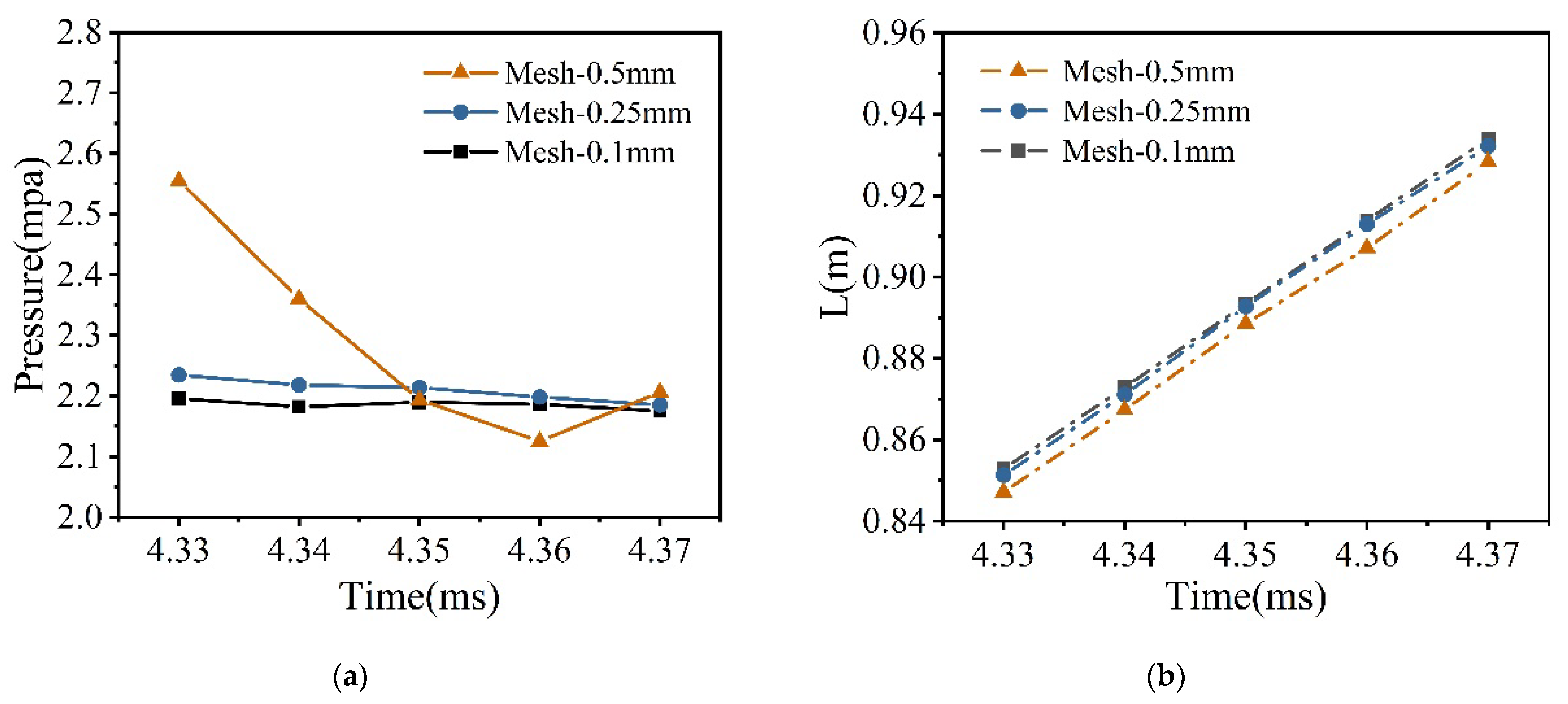
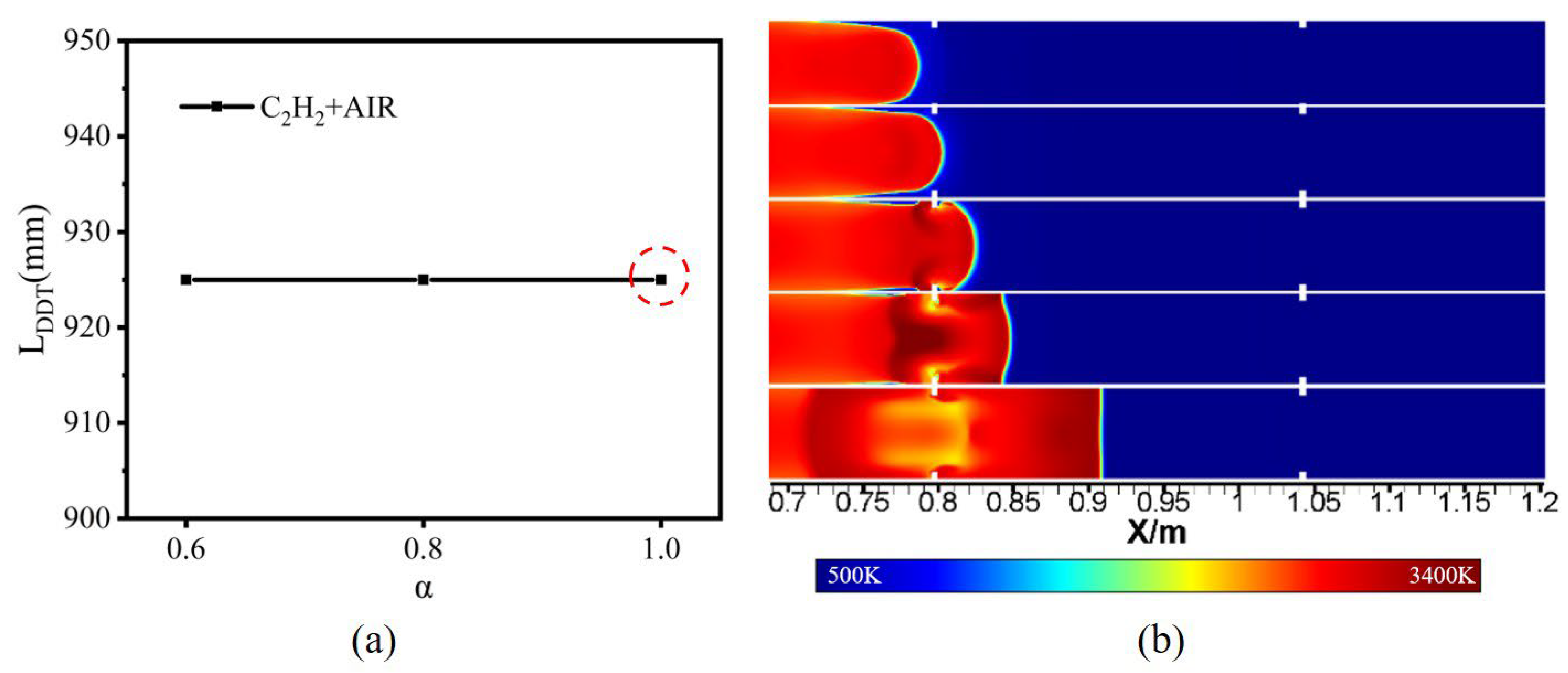




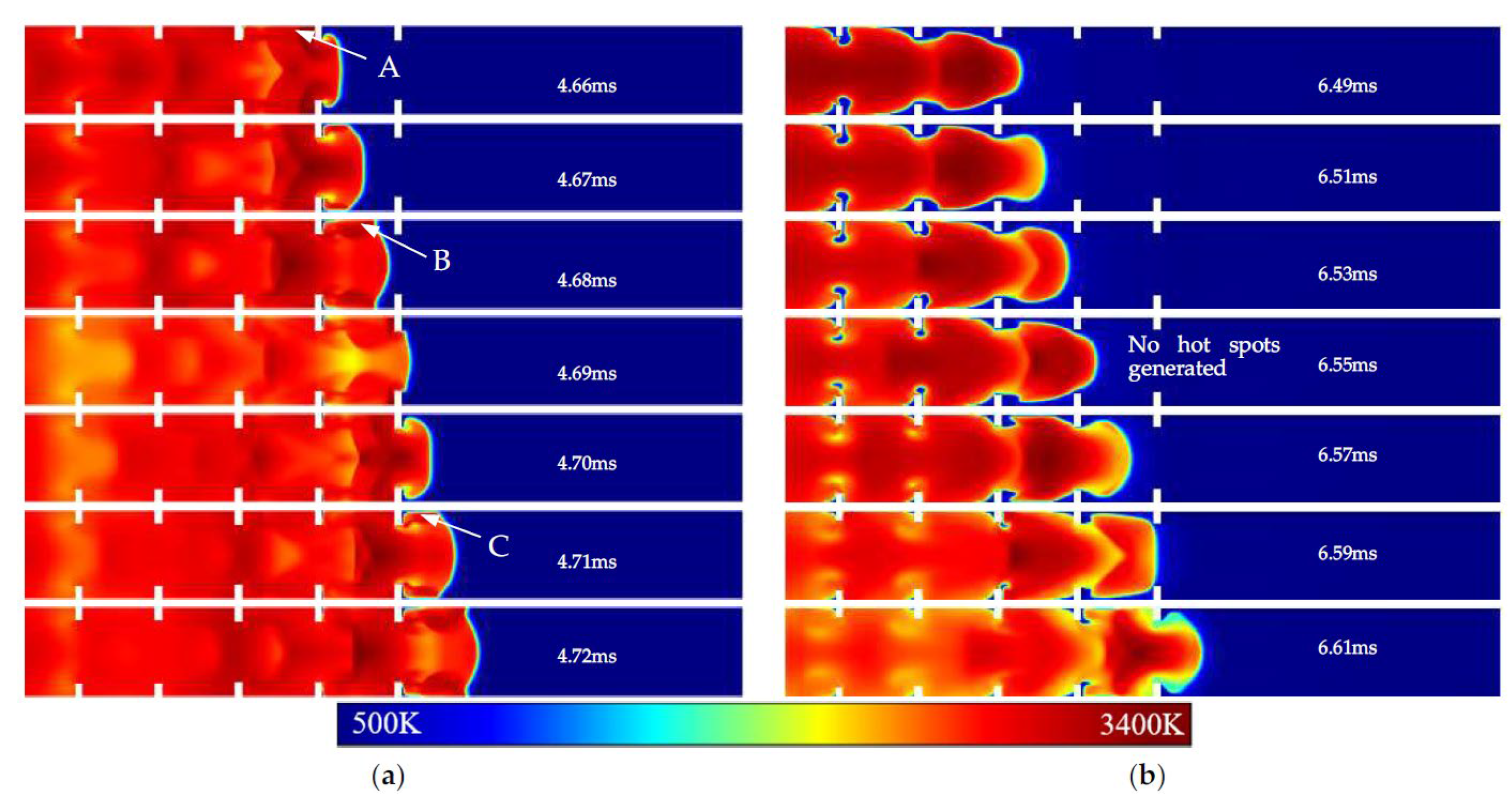
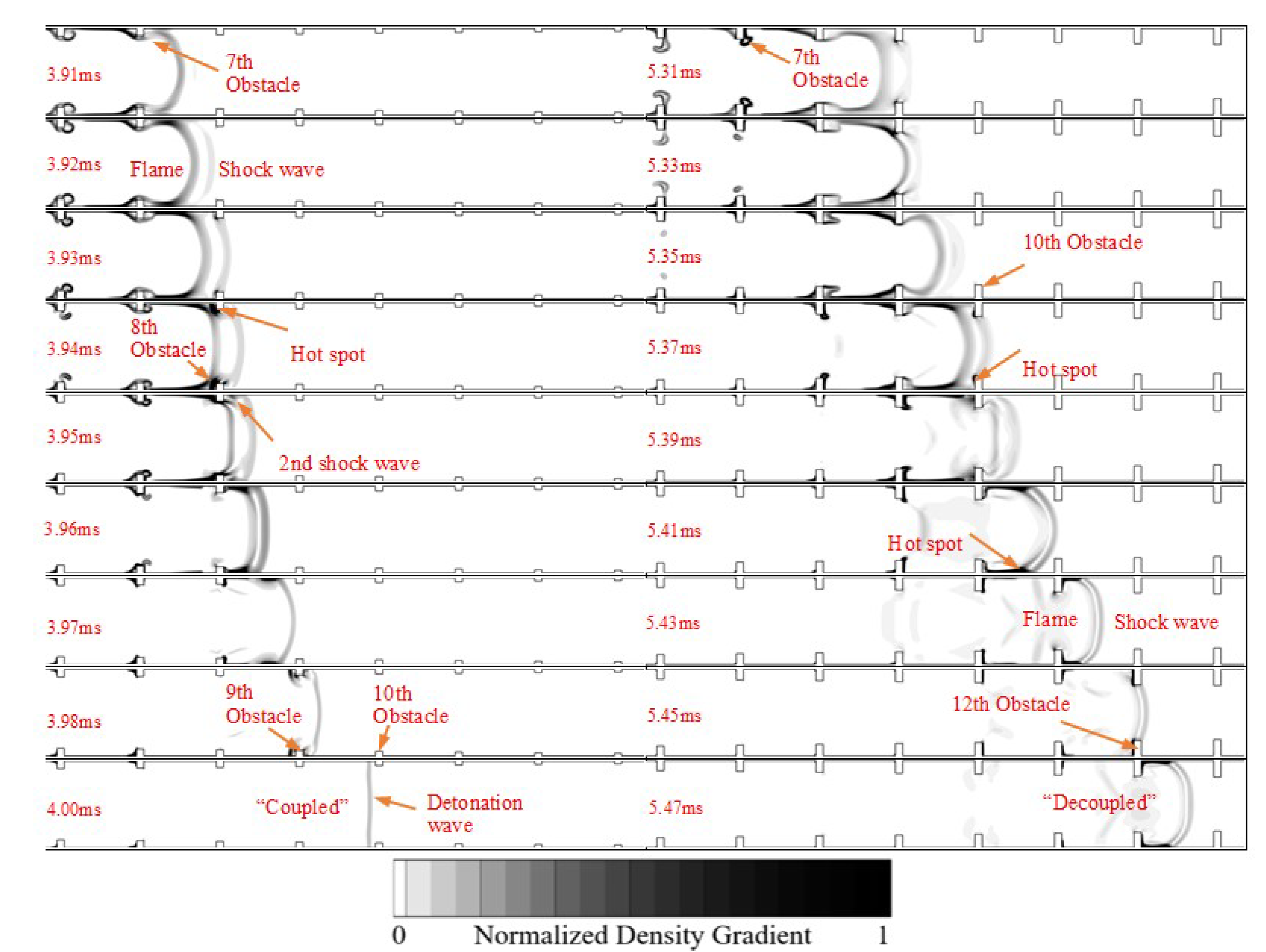




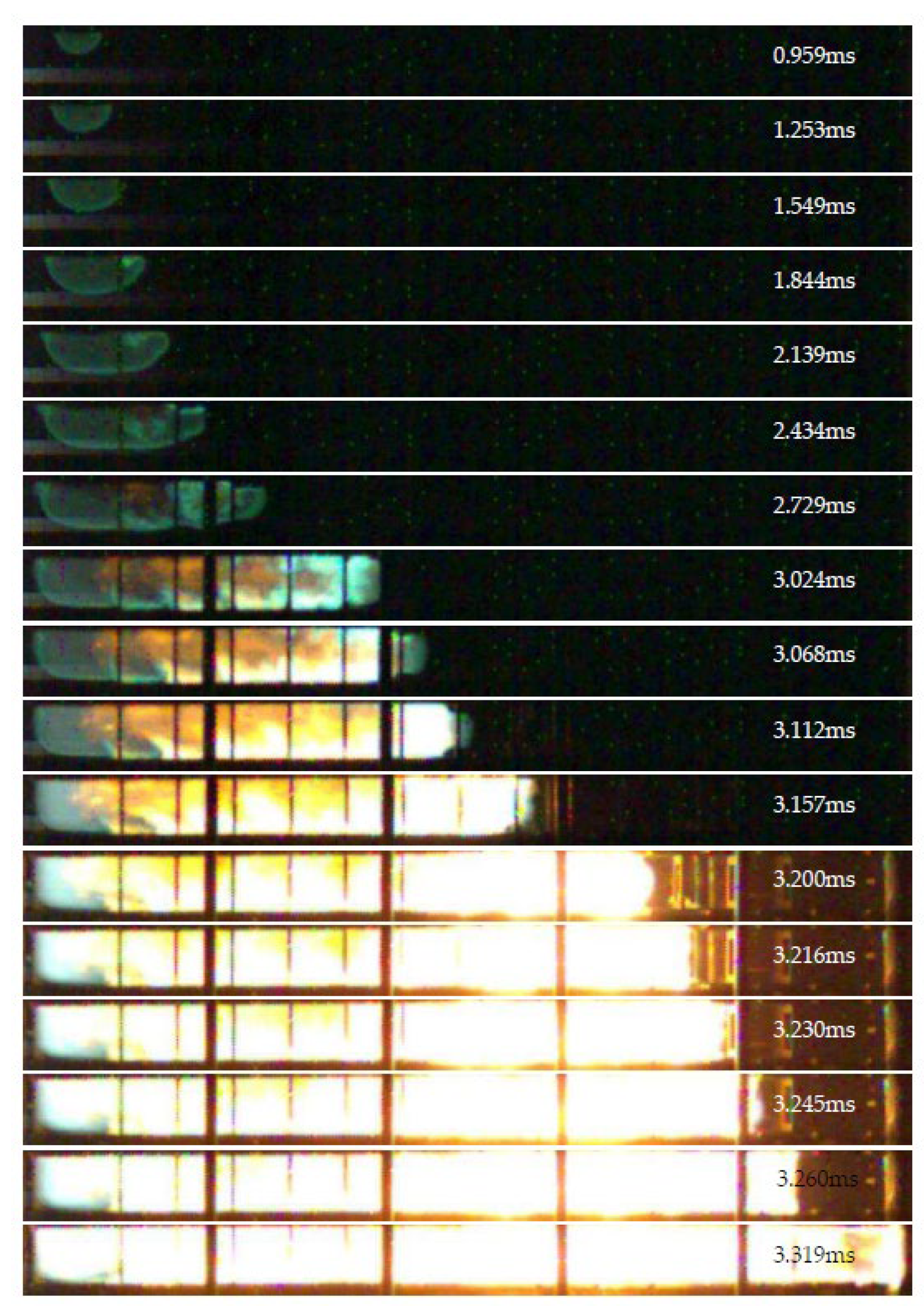
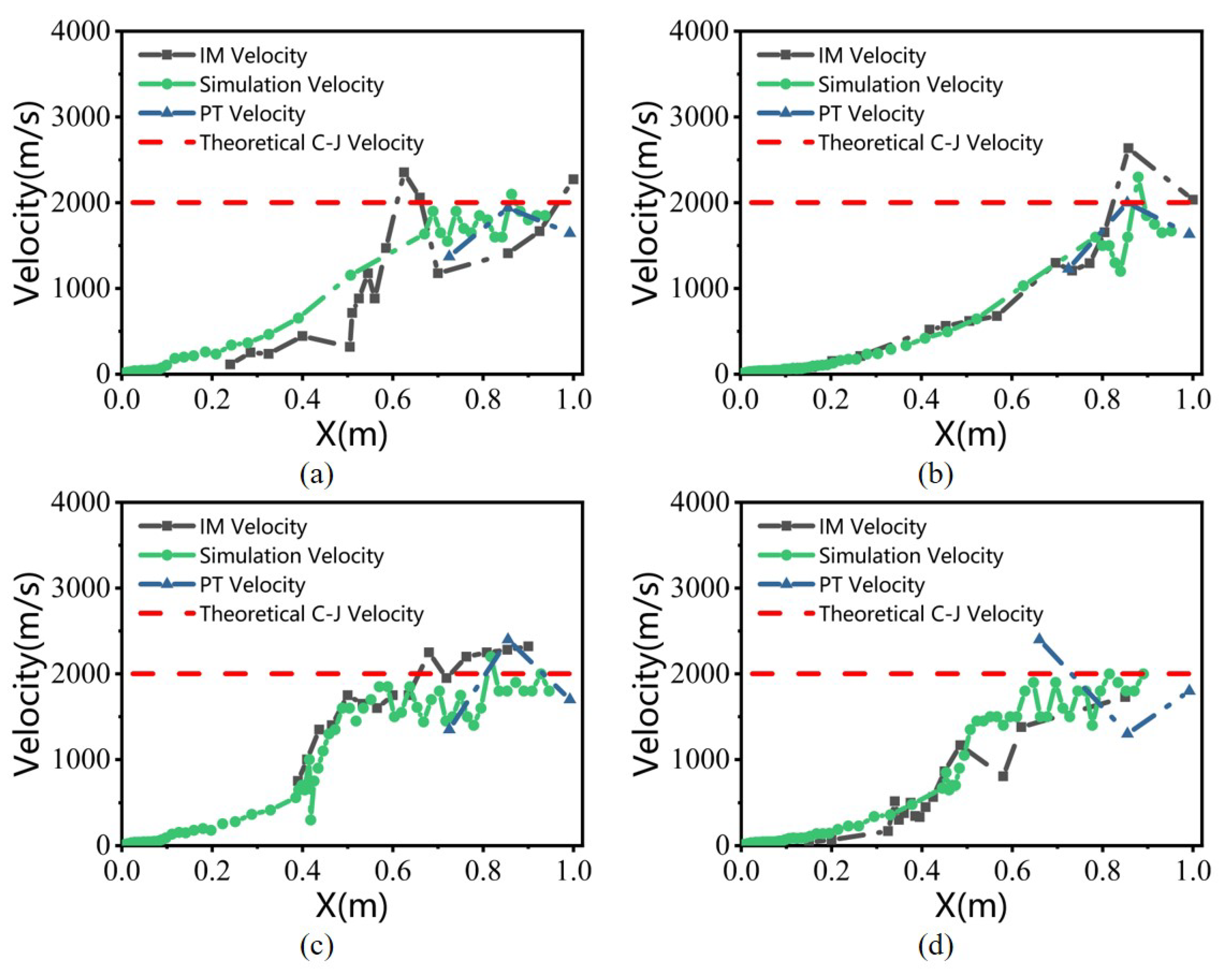
| Model Parameter | CEA | 12-Species 24-Step Reaction Mechanism |
|---|---|---|
| Temperature (K) | 3197 | 3200 |
| Pressure (atm) | 20.86 | 21 |
| Velocity (m/s) | 2001 | 1950 |
| h1 = 0.5 mm | 0.0038 ms | 182 K | 0.543 mpa |
| h2 = 0.25 mm | 0.00338 ms | 87 K | 0.142 mpa |
| h3 = 0.1 mm | 0.00324 ms | 43 K | 0.036 mpa |
| A0 | 11.626 | 1.645 | 3.666 |
| A1 | 1.034 | 1.055 | 0.978 |
| Case No. | α | BR Changing Trend | Hot Spot | DDT Distance | |
|---|---|---|---|---|---|
| Case1-0 | 0.43 | 0 | (0.43–0.43) | 0.573 m | 0.87 m |
| Case1-1 | 0.02 | (0.55–0.31) | 0.841 m | 0.919 m | |
| Case1-2 | (0.31–0.55) | 0.566 m | 0.886 m | ||
| Case1-3 | (0.49–0.37–0.47) | 0.508 m | 0.811 m | ||
| Case1-4 | (0.37–0.49–0.39) | 0.557 m | 0.813 m | ||
| Case1-5 | 0.03 | (0.61–0.25) | 0.550 m | 0.848 m | |
| Case1-6 | (0.25–0.61) | 0.613 m | 0.884 m | ||
| Case1-7 | (0.52–0.34–0.49) | 0501 m | 0.806 m | ||
| Case1-8 | (0.34–0.55–0.37) | 0.551 m | 0.808 m | ||
| Case1-9 | 0.04 | (0.67–0.19) | 0.515 m | 0.819 m | |
| Case1-10 | (0.19–0.67) | 0.815 m | 0.861 m | ||
| Case1-11 | (0.55–0.31–0.51) | 0.498 m | 0.825 m | ||
| Case1-12 | (0.31–0.55–0.35) | 0.618 m | 0.783 m |
Publisher’s Note: MDPI stays neutral with regard to jurisdictional claims in published maps and institutional affiliations. |
© 2022 by the authors. Licensee MDPI, Basel, Switzerland. This article is an open access article distributed under the terms and conditions of the Creative Commons Attribution (CC BY) license (https://creativecommons.org/licenses/by/4.0/).
Share and Cite
Feng, X.; Huang, X. Influence of Variable Blocking Ratio on DDT Process. Energies 2022, 15, 7706. https://doi.org/10.3390/en15207706
Feng X, Huang X. Influence of Variable Blocking Ratio on DDT Process. Energies. 2022; 15(20):7706. https://doi.org/10.3390/en15207706
Chicago/Turabian StyleFeng, Xiangzhou, and Xiqiao Huang. 2022. "Influence of Variable Blocking Ratio on DDT Process" Energies 15, no. 20: 7706. https://doi.org/10.3390/en15207706
APA StyleFeng, X., & Huang, X. (2022). Influence of Variable Blocking Ratio on DDT Process. Energies, 15(20), 7706. https://doi.org/10.3390/en15207706





